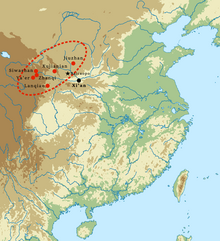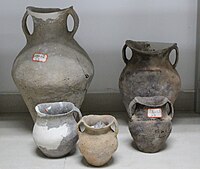 Area map of the Siwa culture, with main sites ( Area map of the Siwa culture, with main sites ( | |||||||
| Geographical range | upper Yellow River | ||||||
|---|---|---|---|---|---|---|---|
| Period | Bronze Age | ||||||
| Dates | c. 1300 – c. 600 BCE | ||||||
| Preceded by | Majiayao culture Qijia culture | ||||||
| Followed by | Ordos culture Shajing culture Han dynasty | ||||||
| Chinese name | |||||||
| Simplified Chinese | 寺洼文化 | ||||||
| |||||||
The Siwa culture (Chinese: 寺洼文化; pinyin: Sìwā wénhuà, ca. 1350-650 BCE) was a Bronze Age culture in southeast Gansu Province, China. It was discovered by Swedish geologist Johan Gunnar Andersson in 1924 at Mount Siwa (寺洼山) in Lintao County, hence its name. It flourished circa 14th to 11th century BC, it is tentatively attributed to the cultures of the Northern Di, Qiang, and Xunyu peoples.
The archaeological culture is divided into two phases: the early phase associated with the sites at Lintao, Zhuoni, Lintan, and Heshui; and, the final phase during the late Shang and proto-Zhou periods associated with the Jiuzhan, Xujianian, and Lanquiao sites. Siwa culture is known for producing a type of pottery that had saddle-shaped mouths.
Context

The Siwa culture followed the disintegration of the Qijia culture. This opened a period of interaction and conflict between the Siwa and the people of the Central Plains.
The Siwa culture has often been associated with the tribes appearing in Chinese historical sources, such as the Rong (Xirong, Shanrong, Quanrong...) or the Qiang. These tribes, whose captives sometimes were sacrificed in Shang dynasty rituals, ultimately toppled the Western Zhou dynasty in 771 BCE. The Siwa people produced relatively abundant ceramics, reflecting a rather varied diet.
The neighboring Xindian culture was roughly contemporary with the Siwa culture and was influenced by it. Some scholars hold that Siwa culture descended from the Qijia culture. There are also those who believe that the culture was a remnant of Xunyu, which is associated with the Xianyun people. However, questions are raised against this theory since Siwa sites are small with low subsistence levels. According to Feng Li, these could not have sustained an advanced society like the Xianyun. The debate remains open.
The Siwa culture was followed by the appearance of Eurasian steppe cultures, particularly Saka cultures such as the Ordos culture, which again interracted in various ways with the Central Plains.
Geography
Siwa culture is divided into two types – Siwa and Anguo. The former is distributed along the Tao River (Taohe) and the latter along the Wei River. The Siwa type is somewhat earlier than the Western Zhou dynasty, while the Anguo type is more or less contemporaneous with it.
One of Siwa culture's main characteristics is pottery with saddle-shaped openings (马鞍口陶罐), It is also distinguished by its bronze objects.
Since 2006, the Siwa site (寺洼遗址) is on the list of the People's Republic of China's archeological monuments.
-
 A selection of Ma’an style vessels from the Zhanqi cemetery. Siwa culture
A selection of Ma’an style vessels from the Zhanqi cemetery. Siwa culture
-
 Siwa culture. Use-wear alteration marks of Zhanqi li vessels.
Siwa culture. Use-wear alteration marks of Zhanqi li vessels.
-
 Siwa culture. Ma’an vessels.
Siwa culture. Ma’an vessels.
-
 Map of Bronze Age China; the Siwa culture area is similar to the Qijia culture (#3)
Map of Bronze Age China; the Siwa culture area is similar to the Qijia culture (#3)
References
 -1000
-1000cultureMezhovskaya
cultureCimmeriansIranian
pastoral
peopleSlab-
gravesKuban
cultureASSYRIAELAMMumunArameansPainted
Grey WareSwatKuruChustSubeshiUpper
XiajiadianSiwa
cultureShanmaDeer
stonesZHOU
DYNASTYSan-
xingduiUlaan-
zuukhKUSH21st
Dynasty
of Egyptclass=notpageimage| General location of the Siwa culture (1350-650 BCE), and contemporary Asian polities c. 1000 BCE
- ^ Taché, Karine; Jaffe, Yitzchak; Craig, Oliver E.; Lucquin, Alexandre; Zhou, Jing; Wang, Hui; Jiang, Shengpeng; Standall, Edward; Flad, Rowan K. (29 April 2021). "What do "barbarians" eat? Integrating ceramic use-wear and residue analysis in the study of food and society at the margins of Bronze Age China". PLOS ONE. 16 (4): e0250819. Bibcode:2021PLoSO..1650819T. doi:10.1371/journal.pone.0250819. ISSN 1932-6203. PMC 8084173. PMID 33914818.
The Siwa archaeological culture (ca. 3350 and 2650 cal yr BP) has often been associated with the tribes referenced in textual sources as Qiang and Rong: prized captives commonly sacrificed by the Shang and marauding hordes who toppled the Western Zhou dynasty. In early Chinese writings, food plays a key role in accentuating the 'sino-barbarian' dichotomy believed to have taken root over 3000 years ago, with the Qiang and Rong described as nomadic pastoralists who consumed more meat than grain and knew little of proper dining etiquette. (...) the Siwa community of Zhanqi. Use-wear analysis shows that Zhanqi community members were sophisticated creators of ceramic equipment, the ma'an cooking pot, which allowed them to prepare a wide number of dishes with limited fuel. These findings support recent isotope studies at Zhanqi as well as nuance the centrality of meat in the Siwa period diet.
- These sites are also called Miaopingyagou yizhi 庙坪鸦沟遗址.
- "灞陵桥寺洼遗址成为全国重点文物保护单位--中国甘肃网". Archived from the original on 2012-03-16. Retrieved 2011-01-11.
- Hu, Qianying 胡謙盈, "Lun Siwa wenhua" 論寺洼文化, Wenwu jikan 文物集刊 2 (1980), 123-4 of 118–24. Cited in Li, Feng (2006), Landscape And Power In Early China, Cambridge University Press. p. 187
- 甘肃日报 . 《走进临洮县寺洼文化遗址》 . 2007. Accessed 17 Dec 2013. (in Chinese)
- ^ Linduff, Katheryn M.; Sun, Yan; Cao, Wei; Liu, Yuanqing (2018). Ancient China and its Eurasian Neighbors: Artifacts, Identity, and Death on the Frontier, 3000–700 BCE. New York: Cambridge University Press. p. 168. ISBN 978-1-108-41861-4.
- "灵台白草坡 西周墓葬里的青铜王国". www.kaogu.net.cn. The Institute of Archaeology (CASS Chinese Academy of Social Sciences).
There is research on the ethnic image of the northern nomadic people of the Altaic language family. It may be that this is the image of the Xianyun tribe that once posed a serious military threat to the northern border of the Zhou Dynasty. They were called "Ghost people" (Guifang) because they looked different from the Chinese. 有考证系阿尔泰语系的北方游牧民族人种形象。可能是曾经对周朝北方边境构成严重军事威胁的猃狁部族,因相貌异于华夏,被称作"鬼方"。
- ^ Dong, Jiajia; Wang, Shan; Chen, Guoke; Wei, Wenyu; Du, Linyao; Xu, Yongxiang; Ma, Minmin; Dong, Guanghui (2022). "Stable Isotopic Evidence for Human and Animal Diets From the Late Neolithic to the Ming Dynasty in the Middle-Lower Reaches of the Hulu River Valley, NW China". Frontiers in Ecology and Evolution. 10. doi:10.3389/fevo.2022.905371. ISSN 2296-701X.
The archaeological culture in this area became more complex after the disintegration of the Qijia Culture. The collision-integration initially occurred between native Siwa Culture and Central Plains cultures, followed by Eurasian steppe cultures and indigenous cultures that later converged and exchanged again (Li et al., 1993; Wang, 2012).
- Anne P. Underhill, ed., A Companion to Chinese Archaeology. Wiley Blackwell Companions to Anthropology. John Wiley & Sons, 2013 ISBN 1118325788
- ^ Feng, Li (2006). Landscape and Power in Early China: The Crisis and Fall of the Western Zhou 1045–771 BC. Cambridge: Cambridge University Press. p. 187. ISBN 978-1-139-45688-3.
- Shelach, Gideon (2008). "Review of Landscape and Power in Early China: The Crisis and Fall of the Western Zhou 1045-771 BC". The Journal of Asian Studies. 67 (1): 281–284. doi:10.1017/S0021911808000259. ISSN 0021-9118. JSTOR 20203333. S2CID 162972022.
Li argues that the Xianyun cannot be identified with the archaeological remains of the Siwa culture because all the sites that are associated with this archaeological culture are small and simple, whereas the activities of the Xianyun suggest a much more complex society (p. 187). While this observation makes sense, it may have more to do with the problematic definition of the archaeological "culture" rather than with Xianyun society. Pushing the location of the Xianyun further north and identifying them with a vaguely defined "Northern Zone" tradition (p. 188) certainly does not advance our under standing of the Xianyun society.
- An Zhimin (1996), THE BRONZE AGE IN EASTERN PARTS OF CENTRAL ASIA. (PDF) Unesco.org
- "Far East Asian Art". Archived from the original on 2012-07-30. Retrieved 2011-01-11.
Further reading
- Nicola Di Cosmo (1999), The Northern Frontier in Pre-Imperial China//The Cambridge History of Ancient China: From the Origins of Civilization to 221 BC, Edited by M.Loewe and E.L.Shaughnessy. ISBN 0-521-47030-7
| Prehistoric cultures of China | |
|---|---|
| Northeastern China | |
| Upper Yellow River | |
| Middle Yellow River | |
| Lower Yellow River | |
| Middle and Upper Yangtze | |
| Lower Yangtze and Huai | |
| Southern China | |
| Tibet | |
| Xinjiang | |
| Taiwan | |
| Other | |